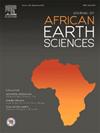The potential of Middle Eocene to early Miocene benthic foraminifera as paleoecological indicators in the Qattara Depression, Western desert, Egypt
IF 2.2
4区 地球科学
Q2 GEOSCIENCES, MULTIDISCIPLINARY
引用次数: 0
Abstract
A comprehensive investigation and analysis were conducted on a total of 105 benthic foraminiferal species. They were extracted from the subsurface Middle Eocene to Lower Miocene strata in the N. El Faras - 1X Well, located in the Qattara Depression of the northern Western Desert, Egypt. The stratigraphic succession primarily encompasses the upper part of the Apollonia Formation (middle to late Eocene), the Dabaa Formation (late Eocene and Oligocene), and the lower part of the Moghra Formation (Early Miocene). Paleoecological multi-proxies analysis were leveraged, including Total Foraminiferal Number (TFN), Planktonic/Benthic Ratio (%P), Species Richness (SR), Diversity Index (Fisher alpha index), Ternary plot for foraminiferal assemblage structure, Agglutinated/Calcareous Ratio (Aggl/Calc), Epifaunal/Infaunal Ratio (Ep/In), and the Trophic-Oxygen (TROX) Model.
Qualitative and quantitative analyses of the encountered benthic foraminifera, alongside CONISS cluster analysis, facilitated the delineation of five distinct clusters, each characterized by unique fossil content and paleoenvironmental attributes. Generally, the first cluster was characterized by oxic to dysoxic conditions and oligotrophic to highly oligotrophic conditions within middle to outer neritic setting. Clusters 2 and 3 were characterized by oxic to dysoxic conditions and oligotrophic to mesotrophic settings. The fourth cluster exhibited oxic to dysoxic conditions alongside mesotrophic to eutrophic conditions, and situated within a middle neritic and euphotic zone. Lastly, the fifth cluster demonstrated a gradual decrease in paleodepth within the inner neritic and euphotic zone, featuring a well oxygenated environment and mesotrophic to eutrophic conditions.

埃及西部沙漠Qattara坳陷中始新世至早中新世底栖有孔虫作为古生态指示物的潜力
对105种底栖有孔虫进行了全面调查和分析。它们是在埃及西部沙漠北部Qattara坳陷N. El Faras - 1X井的中始新世至中新世下部地层中提取的。地层演替主要包括阿波罗尼亚组上半段(始新世中晚期)、达巴组(始新世晚期至渐新世)和莫格拉组下半段(中新世早期)。利用古生态多指标分析,包括有孔虫总数量(TFN)、浮游/底栖比(%P)、物种丰富度(SR)、多样性指数(Fisher alpha指数)、有孔虫组合结构三元图、凝集/钙质比(Aggl/Calc)、地表/水栖比(Ep/In)和营养-氧模型(TROX)。对所发现的底栖有孔虫进行定性和定量分析,并结合CONISS聚类分析,有助于划分出五个不同的聚类,每个聚类都具有独特的化石含量和古环境属性。一般来说,第一个集群的特征是缺氧到缺氧状态,在中到外浅海环境中,低营养到高度低营养状态。集群2和集群3的特点是缺氧到缺氧条件和少营养到中营养环境。第四个集群表现出缺氧到缺氧以及中营养化到富营养化的状态,位于中浅海和泛光区。最后,第5群在浅海和泛绿带内表现出古深度逐渐下降的特征,具有良好的含氧环境和中营养化到富营养化的条件。
本文章由计算机程序翻译,如有差异,请以英文原文为准。
求助全文
约1分钟内获得全文
求助全文
来源期刊

Journal of African Earth Sciences
地学-地球科学综合
CiteScore
4.70
自引率
4.30%
发文量
240
审稿时长
12 months
期刊介绍:
The Journal of African Earth Sciences sees itself as the prime geological journal for all aspects of the Earth Sciences about the African plate. Papers dealing with peripheral areas are welcome if they demonstrate a tight link with Africa.
The Journal publishes high quality, peer-reviewed scientific papers. It is devoted primarily to research papers but short communications relating to new developments of broad interest, reviews and book reviews will also be considered. Papers must have international appeal and should present work of more regional than local significance and dealing with well identified and justified scientific questions. Specialised technical papers, analytical or exploration reports must be avoided. Papers on applied geology should preferably be linked to such core disciplines and must be addressed to a more general geoscientific audience.
 求助内容:
求助内容: 应助结果提醒方式:
应助结果提醒方式:


